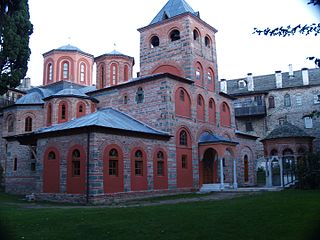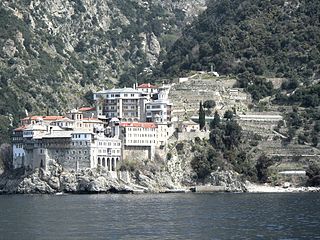
The Monastery of Great Lavra is the first monastery built on Mount Athos, on the Athos peninsula in northeastern Greece. It is located on the southeastern foot of the Mount at an elevation of 160 metres (170 yd). The founding of the monastery in AD 963 by Athanasius the Athonite marks the beginning of the organized monastic life at Mount Athos. At the location of the monastery, there was one of the ancient cities of the Athos peninsula, perhaps Akrothooi, from which the sarcophagi of the monastery that are in the oil storage house come. The history of the monastery is the most complete compared to the history of the other monasteries, because its historical archives were preserved almost intact. It is possible that the study of these archives may contribute to the completion of the knowledge of the history of other monasteries, whose archives were partially or completely lost.

The Holy and Great Monastery of Vatopedi is an Eastern Orthodox monastery on Mount Athos, Greece. The monastery was expanded several times during its history, particularly during the Byzantine period and in the 18th and 19th centuries. More than 120 monks live in the monastery.

Simonopetra Monastery, also Monastery of Simonos Petra, is an Eastern Orthodox monastery in the monastic state of Mount Athos in Greece. It ranks 13th in the hierarchy of the Athonite monasteries.

Dionysiou Monastery is an Eastern Orthodox monastery at the monastic state of Mount Athos in Greece, at the southwest part of the Athos peninsula. The monastery ranks fifth in the hierarchy of the Athonite monasteries. It is one of the twenty self-governing monasteries in Athos, and it was dedicated to John the Baptist.

Pantokratoros Monastery is a Greek Orthodox monastery in the monastic state of Mount Athos in Greece. It stands on the north-eastern side of the Athos peninsula, and is dedicated to the Transfiguration of Our Lord. The monastery ranks seventh in the hierarchy of the Athonite monasteries.

The Docheiariou monastery is an Eastern Orthodox monastery at the monastic state of Mount Athos in Greece.

The Karakallou Monastery is an Eastern Orthodox monastery at the monastic state of Mount Athos in Greece. It stands on the south-eastern side of the peninsula and ranks eleventh in the hierarchy of the Athonite monasteries. The monastery has 50 working monks, and its library holds 330 manuscripts, and about 3,000 printed books.

Philotheou or Filotheou Monastery is an Eastern Orthodox monastery at the monastic state of Mount Athos in Greece. It stands on the north-eastern side of the peninsula.

Agiou Pavlou Monastery is an Eastern Orthodox monastery in the monastic state of Mount Athos, located on the easternmost peninsula of Chalkidiki, Greece. The founder of monastery was Paul of Xeropotamou, after whom it is named.

Stavronikita Monastery is an Eastern Orthodox monastery at the monastic state of Mount Athos in Greece, dedicated to Saint Nicholas. It is built on top of a rock near the sea near the middle of the eastern shore of the Athonite Peninsula, located between the monasteries of Iviron and Pantokratoros. The site where the monastery is built was first used by Athonite monks as early as the 10th century. Stavronikita was the last to be officially consecrated as an Athonite monastery in 1536 and ranks fifteenth in the hierarchy of the Athonite monasteries. It currently has 30 to 40 monks.

The Holy Monastery of Saint Gregory, also known as Gregoriou Monastery is an Orthodox Christian monastery in the monastic state of Mount Athos in Greece. The Monastery ranks seventeenth in the hierarchy of the Athonite monasteries. It is built by the sea, on the southeastern side of the peninsula, neighboring the monasteries of Simonopetras and Dionysiou. Gregoriou is very much a pilgrim friendly monastery with a strong sense of pastoral care. Pilgrim visitors are numerous and well provided for. The Monastery is completely girt by the sea, built on a corner of land jutting into the sea, with only steep craggy rocks backed up behind it.

Saint Panteleimon Monastery, also known as Rossikon or New Russik, is one of the twenty Eastern Orthodox monasteries on Mount Athos, located on the southwestern side of the peninsula in Northern Greece. It is the Russian monastery on the peninsula. It houses exclusively Russian monks, sent by the Russian Orthodox Church, and the liturgies are served in Russian, despite the fact that all monks on Mount Athos eventually become citizens of Greece.

Saint Paisios of Mount Athos, was a well-known Greek Eastern Orthodox ascetic from Mount Athos, originally from Pharasa, Cappadocia. He was respected for his spiritual guidance and ascetic life. Today, he is widely venerated by Eastern Orthodox Christians, particularly in Greece, Romania, Russia, Serbia, Montenegro and Syria.

The monastic community of Mount Athos is an Eastern Orthodox community of monks in Greece who hold the status of an autonomous region with its own sovereignty within Greece and the European Union, as well as the combined rights of a decentralized administration, a region and a municipality, with a territory encompassing the distal part of the Athos peninsula including Mount Athos. The bordering proximal part of the peninsula belongs to the regular Aristotelis community in Central Macedonia.

Saint Joseph the Hesychast was a Greek Orthodox monk and elder who led a small group of monks at Mount Athos. He was canonized as a saint by the Ecumenical Patriarchate of Constantinople in 2020. His annual feast is celebrated on August 16.
Katounakia is an Eastern Orthodox skete of the community of Mount Athos that is subordinate to the Great Lavra. The skete is located between Little Saint Anne's Skete and Karoulia. The skete consists of 22 cells in which about 35 monks live. The cell of Danieleon, which employs some of the best icon painters at Mount Athos, is located in the skete.

Kerasia is a settlement in Mount Athos. It is located at an elevation of 581 metres on the southwestern slopes of the main peak of Mount Athos. Located just to the east of Little St. Anne's Skete and Katounakia, it is inhabited by a few dozen monks.

Karmilio Oros is a peak at the southern end of the Athos peninsula. Its summit is 887 metres above sea level. It is named after Mount Carmel.

The Desert of Mount Athos or Wilderness of Mount Athos is a geographical area of Mount Athos that corresponds to the southern slopes of Mount Athos. Located along the southernmost coast of the Athos peninsula, it stretches roughly from Katounakia in the west to Vigla in the east. The Desert of Mount Athos has been a center of Christian asceticism and hesychasm for over 1,000 years.



















